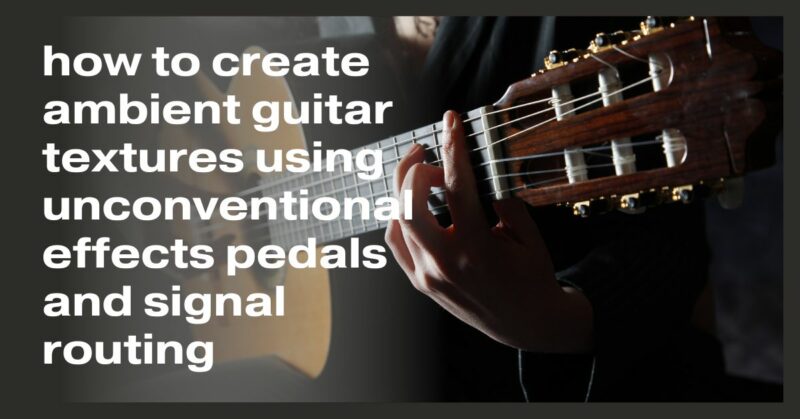Ambient guitar textures transport listeners to dreamlike realms, painting soundscapes with ethereal, otherworldly tones. While traditional effects pedals like reverb and delay play a significant role in shaping ambient guitar sounds, the magic often lies in experimenting with unconventional effects pedals and intricate signal routing techniques. In this article, we’ll delve into the creative process of crafting ambient guitar textures using non-traditional effects pedals and unique signal routing setups.
1. Choose Your Canvas: The Guitar and Amp Setup
Before diving into effects pedals and signal routing, it’s essential to start with a solid foundation. Your choice of guitar and amplifier significantly influences the ambient textures you can create. Single-coil pickups often yield clear, bell-like tones, while humbuckers offer a thicker, more saturated sound. Similarly, tube amplifiers can produce warm, harmonically rich tones, perfect for ambient guitar work.
2. Beyond Reverb and Delay: Unconventional Pedals
While reverb and delay are ambient music staples, unconventional effects pedals can elevate your sonic explorations:
- Modulation Pedals: Chorus, phaser, flanger, and tremolo pedals introduce dynamic movement and depth to your sound. Experiment with various settings to create subtle, evolving textures.
- Pitch-Shifting Pedals: Pitch-shifters can take your guitar’s sound to otherworldly heights. Combine octavers, harmonizers, and pitch-shifters to craft ambient harmonies and ambient swells.
- Granular Synthesis and Looper Pedals: These pedals allow you to manipulate and loop audio in real-time, transforming your guitar’s sound into a mesmerizing, evolving texture.
- Filter and Wah Pedals: Filters and wahs can sculpt your guitar’s tone, adding dynamic sweeps and textures to your soundscapes.
3. The Art of Layering: Signal Routing
Signal routing is where the real magic happens in crafting ambient guitar textures. Here are some techniques to consider:
- Parallel Processing: Split your guitar signal into two or more paths, each processed with different effects. Blend these paths back together for rich, layered textures.
- Feedback Loops: Create feedback loops using pedals to generate self-sustaining soundscapes. Be cautious with high volumes to prevent ear damage.
- Multi-FX Units: Consider using multi-effects units that allow flexible signal routing, letting you experiment with various combinations of effects.
- Pedal Order: The order in which you chain your pedals can dramatically impact the resulting textures. Experiment with different pedal sequences to find what works best for your sonic vision.
4. Expressive Playing: Incorporate Volume Swells and Techniques
Ambient guitar textures are as much about how you play as they are about your gear. Volume swells, achieved by rolling back your guitar’s volume knob, create gradual fades and dynamic shifts in your sound. Incorporate techniques like fingerpicking, harmonics, and bowing to add expressive depth to your playing.
5. Record and Experiment: Capture Your Soundscapes
Recording your ambient guitar experiments is crucial to refining your technique. Experiment with different mic placements and room acoustics to capture the nuances of your soundscapes accurately. Digital audio workstations (DAWs) and effects plugins can further enhance your ambient textures during post-production.
Conclusion: The Journey of Sonic Exploration
Crafting ambient guitar textures using unconventional effects pedals and signal routing is a journey of sonic exploration. It’s about pushing boundaries, experimenting with the unknown, and translating your emotions into ethereal soundscapes. Embrace the freedom to create and let your imagination guide you on a sonic adventure that transports both you and your listeners to captivating, dreamlike realms.

